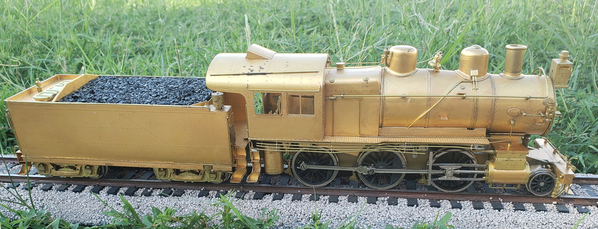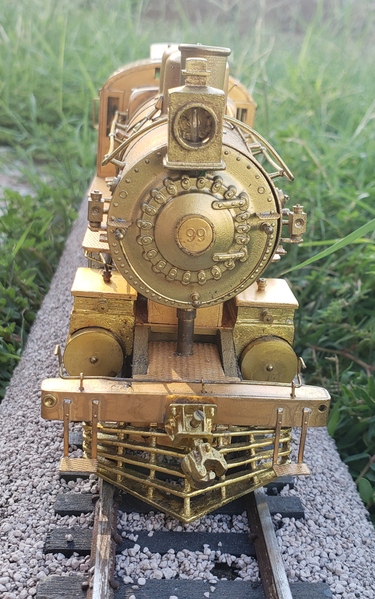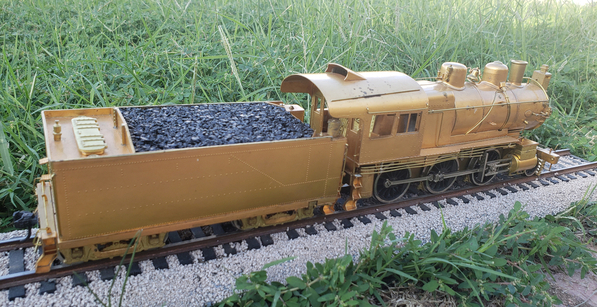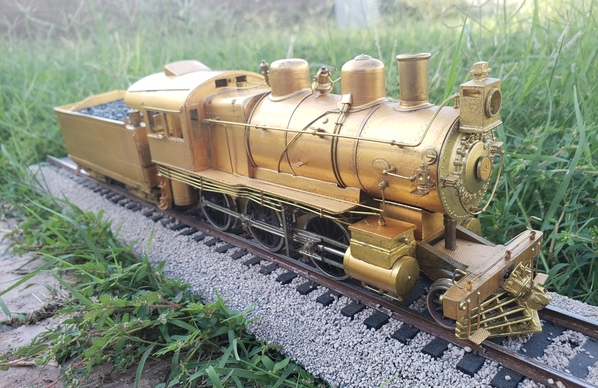I totally forgot about the Weaver A5. That is a very nice model. I have one. I had some maching done on the front of the frame to lower the front deck a little. This loco will pull much more that its size indicates.
Jim
Machining out the rear frame and adding ash hoppers is an upgrade to consider. Another is to turn a correct diameter stack. (stacks on Samhongsa built Williams and Weaver PRR switchers were fat in order to accommodate Seuthe smoke generators). The model below was up-detailed by my late close friend and PRR modelling mentor Ray Jury some 20 years ago. My recent upgrade was installing a Tsunami2 DCC sound decoder.
Attachments
@bob2 posted:I have the Reading 0-4-0, and had the B6sb, but traded it even for the more robust Williams. The Reading had loose drivers, and I suspect it’s gearbox is good for an hour or so. I prefer the Gem cab on the B6, but for everything else I prefer the Williams ( which may be closer to 17/64 Scale). The Williams will run forever.
Edit - that did not answer the question. I consider Gem to be about halfway between IMP (flimsoid) and Max Gray (well built). I would put them just under Pecos River for sturdiness. Opinion, of course.
Just saw this thread. I finally found a Williams brass 2-rail B6. Not expensive, but a lot harder to find than the 3-rail version. I was looking for a Gem B6, but it seems that the Williams is a much better runner out of the box.
The Williams B6 locomotive is larger than the Lionel prewar B6, which I also have. But the Lionel prewar B6 locomotive is undersized, being compressed to about 93% scale sized, according to a Classic Toy Trains article from back in 1993. Of course, the Lionel has a different cab type, but the Williams seems to be pretty close to an exact scale sized model, and not oversized. Has anybody confirmed the measurements?
I have both a Gem and a Williams. I have not measured them, but they are about the same length and what not. AS mentioned above, the Williiams seems to represent a newer version of the prototype than the Gem.
I like them both.
My father in retirement since age 55 has enjoyed working on locomotives, so I gave him to Mogul to toy with and I expect to get it back on Thanksgiving. As always, he will give me a full report on what he found and what he did to it. When I get it back, my plan is to modernize it with an electric headlight and generator. Otherwise, it is a pretty cool locomotive as-is and represents a segment of today's market that is lacking - the small mainline locomotive
Photos pre modifications:
Attachments
I really get a lot of grief when I say the Williams B6 is oversize. Park it next to, say, a PS1 boxcar, then go look at prototype photos.
@bob2 posted:I really get a lot of grief when I say the Williams B6 is oversize. Park it next to, say, a PS1 boxcar, then go look at prototype photos.
Well, that is why I asked about measurements. I also have the Lionel number 701 version of the B6, which was labeled as "scale" by Lionel and made from 1939-1941, and which can commonly be found converted to 2-rail, but it is clearly undersized (the same casting was issued as Lionel number 227, 228, etc. and then reissued around 1989 as Lionel number 18000). All you need to do is look at prototype photos to confirm it. The Lionel locomotive is obviously too small, even though Lionel marketed it as "scale" at the time. Classic Toy Trains did an article about the size of various Lionel and other 3-rail trains and the prewar Lionel B6 was listed as 93% scale sized (unlike the famous prewar Lionel 700E Hudson, which was listed as 100% scale sized). Unlike the locomotive, the prewar Lionel B6 tender looks about right, though. But sitting next to the Williams, the Williams locomotive looks considerably larger. I think the Williams looks correct in proportion to the tender. Based on prototype photos, the B6 was pretty tall at the top of the cab.
I can only speak to the Williams B6 and the prewar Lionel B6, since those are the 2 versions that I have. But PRRJim posted earlier in this thread that he has both the Gem and the Williams versions, and that they are the same size. I think that since the prewar Lionel version has been around for so long, and since it was marketed as "scale", many people are familiar with it and think that it is "correct", thus making the other versions look too large. The reality is that the prewar Lionel B6 was selectively "compressed" just like most other Lionel O gauge items. This can be confirmed by the cab/boiler height and inaccurate compressed driver spacing on the Lionel B6 model. Although the Lionel B6 is still an attractive model, particularly when converted to 2-rail.
@GG1 4877 posted:Otherwise, it is a pretty cool locomotive as-is and represents a segment of today's market that is lacking - the small mainline locomotive
The F3c is a nice moderate sized locomotive, albeit a little early in era for most modelers. But, it is definitely an example of the small mainline locomotive that I'd love to see more of available. Not holding my breath though. ![]()
The following link should take you to a site that has equipment diagrams for PRR equipment.
http://prr.railfan.net/freight/PRRdiagrams.html
Find the B6SB which I think all these models represent and take a look. These diagrams are not blueprints so they do not have all the detailed dimensions, but they do have many major ones. I plan to get my B6s out and do some checking - when a round tuit.
@prrjim posted:The following link should take you to a site that has equipment diagrams for PRR equipment.
http://prr.railfan.net/freight/PRRdiagrams.html
Find the B6SB which I think all these models represent and take a look. These diagrams are not blueprints so they do not have all the detailed dimensions, but they do have many major ones. I plan to get my B6s out and do some checking - when a round tuit.
Thanks for that PRRJim. The B6 cab is 14 feet 11 and 1/8 inches tall (above rail height), so basically 15 feet, which is only one foot shorter than monster-sized locomotives like the S1 and S2. I think that is what makes it look oversized as a model, even though it is accurate. I will measure my Williams and Lionel models a bit later to check (they are both stashed in their boxes right now).











